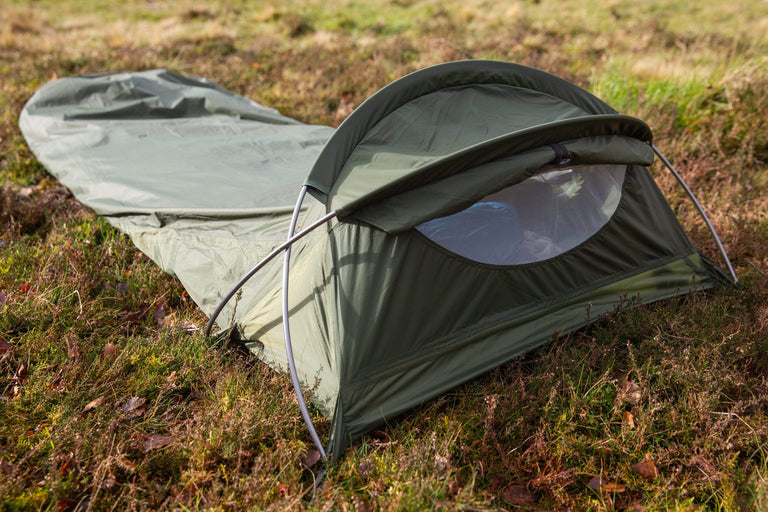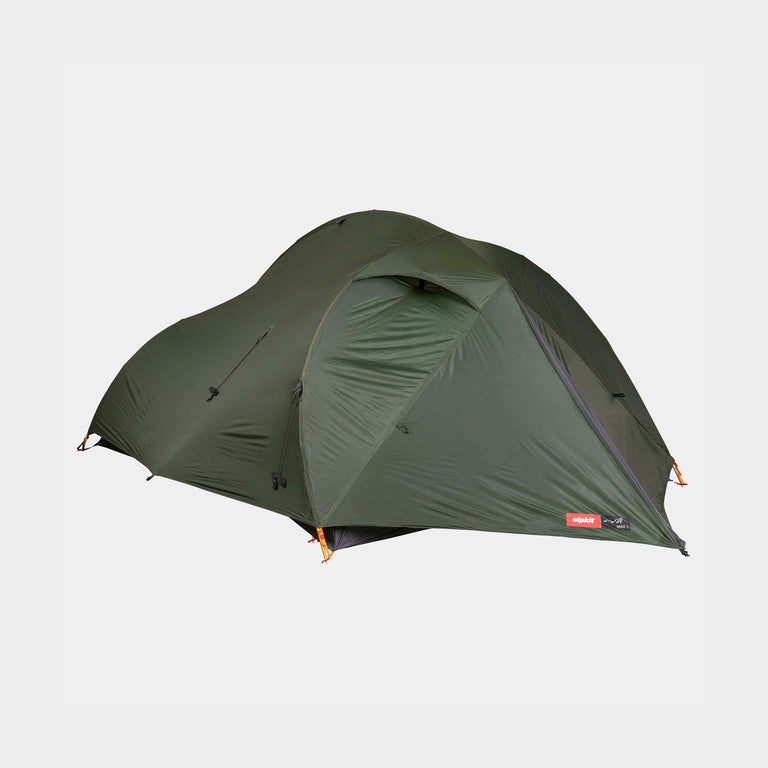
We answer the essential questions about canvas bell tents and cotton canvas tents to help you decide if a canvas tent is perfect for your next camping trip.
With their complex structures, alloy poles and man-made fabrics, backpacking and mountain tents can't be beaten for weight and pack size. But idyllic cotton bell tents are still widely used. It’s not just nostalgia for an authentic night under canvas though; cotton bell tents are fantastic shelters in their own right.

Contents
- What is a bell tent?
- What are bell tents made from?
- What are the benefits of canvas bell tents?
- Are canvas tents waterproof?
- How do you look after a canvas bell tent?
- Should I buy a canvas bell tent?
- How do I put up a bell tent?
What is a bell tent?
Modern bell tents have a circular shaped footprint with the tent fabric supported by a tall central pole. They have a frame-supported doorway, short side walls, and are pegged down using multiple guylines. The canvas is usually made from cotton or polycotton, although wholly synthetic fabrics are occasionally used to reduce pack size, weight and cost.
Circular canvas shelters have existed in various forms for hundreds of years, but the first patented bell tent was developed during the American Civil War by Henry Hopkins Sibley. Sibley drew inspiration from Native American tipis, using the same conical structure and central smoke hole, but using only one central pole instead of twelve for ease of pitching and portability.
While he was the first to register a patent, the British Army were also using circular, single pole tents during the Crimean war. These British Army tents bore a closer resemblance to modern designs with side walls, a raised entrance and multiple guy lines. This isn’t the place for debating the origins of bell tents, but it’s safe to say that the design has been thoroughly tried and tested through the ages.
Bell tent vs yurt
Yurts originated in Central Asia thousands of years ago. They're old. Really old. They have a wooden-lattice structure and would have originally been covered with animal skins. They're pretty big - perfect for a big group or an individual with loads and loads of stuff. Bell tents, on the other hand, are a bit smaller - but still very comfortable! They're very stable structures.

What are bell tents made from and why?
Top of the range bell tents typically use 100% cotton or polycotton canvas (usually a 30% cotton composition) for the walls and a hard-wearing, easy-to-clean synthetic material for the floor. Pure polyester or nylon bell tents are less common as bell tents generally prioritise durability and comfort over pack size and weight. Cotton is heavier and bulkier as a material but it’s significantly more UV resistant, tougher, a better insulator and highly breathable.
We used a polycotton canvas for our own bell tent, the Roundhouse, because it offers the best all-round compromise between natural and synthetic materials. Polycotton canvas maintains the breathability, insulation and long lifespan of cotton but it's lighter, faster drying, has greater tear-resistance and isn’t as susceptible to mildew. We only use organic or Better Cotton Initiative-certified cotton so the cotton used in the Roundhouse is from 100% organic sources.

What are the benefits of canvas bell tents?
1) Full of fresh air
Even a polycotton blend canvas is a significantly more breathable material than pure polyester or nylon. This means the inside of the tent stays almost completely condensation free with none of the muggy, funky mustiness that you can often get in synthetic tents. Staying in a canvas tent is a much more natural experience - we'd much rather wake up to the smell of fresh grass than a combination of hot plastic and our own musk!
2) Bang in the ‘Goldilocks zone’
Because cotton is a better insulator, canvas bell tents are warmer when the temperature drops and stay nice and cool during the day, (rather than turning into a human oven every time the sun comes out). As well as ensuring you get a better night’s sleep, this transforms the tent into a space that you actually want to spend time in – somewhere cool and shady in summer and warm and cosy for the rest of the year.


3) Better resistance to UV
When looked after properly, canvas bell tents can last significantly longer than tents using more modern materials. This is partly down to the canvas being much more resistant to UV than pure polyester or nylon, which deteriorate when left exposed to the sun for long periods. This is less of an issue in backpacking tents which are pitched in the evening and packed early in the morning. But it’s definitely a factor to consider if you’re looking for a big base camp tent to leave pitched for several days at a time.
4) Tents that are built to last
Cotton or polycotton canvas already has greater longevity thanks to its UV resistance. But dense weave, heavy-duty canvas is also much more likely to withstand your usual campsite sharps and debris, and polycotton has the added benefit of enhanced tear-resistance.
Because bell tent manufacturers usually prioritise durability over weight, bell tents tend to use much harder-wearing materials and a more durable construction throughout. For example, our Roundhouse uses a sturdy steel pole, big wooden toggles and a heavy-duty 400D Oxford PU floor. It also uses a seamed construction which isn’t dependent on seam taping to stay waterproof. Adhesives in seam taping can get broken down by water over time through a process called ‘hydrolysis’.
5) Strong and sturdy structure
Circular canvas shelters have been used for hundreds of years and that’s partly down to the inherent stability of their structures. Bell tents are exceptionally stable in strong winds and are strong enough to withstand the additional weight of snowfall. An added bonus to the heavier weight of the material is that you don’t get any irritating flapping noises when the wind picks up.
Early polar explorers adopted single-pole cotton canvas tents, often in a pyramid shape, for their speed of pitching. Realising that a circular floor meant that no one corner was exposed to the wind, Admunsen used his own low-walled circular bell tent design on his successful expedition to the South Pole.
6) Lots of space to live in
With their tall central pole and wide diameters, bell tents create loads of liveable space to spread out in. And thanks to their low walls, nearly all of the tent is usable space too, providing lots of room to move about without the constant fear of bumping into the canvas and breaking its surface tension.
This makes bell tents the perfect choice for longer camping breaks when you’re planning to spend plenty of time hanging around the campsite (or if you’re forced to by bad weather!). Designed primarily as a tent for two people, our 3m diameter Roundhouse is at the smaller end of the scale for bell tents, but there’s still plenty of room for a camping table and chairs inside. (And 6ft 4 Product Developer Rowan!)



7) A more sustainable option
There’s no denying that natural materials cost more than man-made ones. However, when you consider the greater longevity of canvas tents, there’s not a huge amount in it in terms of cost per night. Canvas tents can last up to 4 times longer than their polyester or nylon equivalents and, with the right care, a canvas bell tent could last you years.
Plus, because canvas doesn’t deteriorate as quickly in UV, if you are unfortunate enough to damage your tent fabric, it’s easy and cost-effective to repair too. We’ve tried to make our Roundhouse more sustainable in as many ways as possible, choosing 100% organic cotton, FSC-certified wooden toggles and strong, reliable materials that will extend the tent’s lifespan.
8) Clap your eyeballs on that!
If you’re not sold on the increased comfort, space, stability, sustainability and lifespan, there’s no denying the aesthetic appeal of a canvas bell tent: one hundred percent homely!

What makes canvas tents waterproof?
It’s easy to believe that a plasticky nylon flysheet will keep you dry in the mother of all rain storms, but with canvas it’s a little more confusing. How on earth does a sheet of cotton or polycotton keep you dry in the wet?
Well, it’s partly to do with the weave. Canvas uses an exceptionally dense weave of fibres which leaves very few spaces for water droplets to squeeze through. When you pitch a canvas sheet taut and at an angle, the surface tension of the fabric cause water droplets to run straight off rather than soak in.
But there are still gaps in the weave? Yep, but here’s the really clever part. When cotton gets damp, the fibres start to absorb moisture and swell. This swelling closes off any remaining spaces in the canvas, seals up any holes made by the stitching, and ensures that you stay nice and dry while the rain drums down outside.


How to look after a cotton canvas bell tent
Weathering in
Canvas tents always need ‘weathering in’ before their first use or after a prolonged period of storage. This process seals up any spaces in the canvas or the stitching and ensures that your tent is completely waterproof if it does rain while you’re away. All you have to do is pitch your tent outside in wet weather or give it a thorough soaking with a hose, allowing the tent to dry fully before packing it away.
Preventing mould and mildew
Cotton canvas is susceptible to mildew if left damp for a long time. You must always ensure that your tent is completely dry before packing it away for a prolonged periods. We use polycotton canvas in our Roundhouse which is faster drying and more resistant to mildew, but it still requires the same level of care.


Should I buy a canvas bell tent?
Canvas bell tents do have some drawbacks compared to other tents. The materials used are more expensive, significantly heavier and result in larger pack sizes. They also require more careful care to stay in top condition. If you need a lightweight shelter you can carry, or if your tent is only ever somewhere dry to rest your head between activities, you might find a cheaper polyester or nylon tent meets your needs just as well.
But for regular campsite campers who go away for several days at a time, year after year, it’s hard to think of many better options. The greater durability and longevity of canvas bell tents means they’re deceptively good value – especially if you look after them – and a much more sustainable choice. Plus, a 3 metre bell tent like the Roundhouse still packs away neatly into a luggage-sized bag that won't take up your entire boot.
You won’t get much comfier or cosier than a canvas bell tent. If you enjoy the simple pleasures of camping – the fresh air and the slower pace of life – you'd do well to find a more welcoming home from home.
How do I put up a bell tent?
Here's our handy video on how to pitch a bell tent.
































